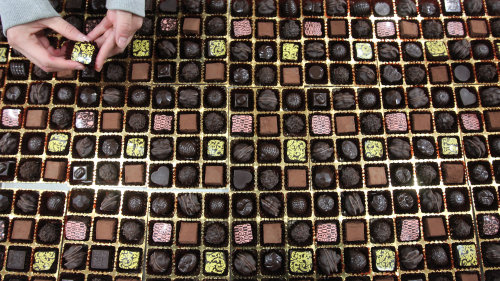If chocolate’s the thing for your sweetie on Valentine’s Day, why give plain old candy when you can give a chocolate plant (Theobroma cacao)?

THE CHALLENGE OF CHOCOLATE
Growing chocolate from seed is difficult. Fresh, they are covered with what looks like a cottony mass that keeps them properly moist for sprouting. The covering is slimy, though, and starts to rot away as soon as the seeds are out of the pods.
Still, you might want to give the seeds as a gardening challenge, perhaps nestled in a gift box on some moist, real cotton. To sprout, the seeds need warmth and well-drained soil. Fresh seeds are available online at Montosgardens.com and Organicfarm.net.
A chocolate plant that’s up and growing makes a more dramatic gift than a few seeds snuggled in cotton. (Plants are widely available online.) But caring for an already growing chocolate plant is still a challenge.
Chocolate is native to the tropical lowlands of Central and South America within 20 degrees on either side of the equator. There, neither the temperature nor the humidity ever drops much below about 70 degrees Fahrenheit (21 Celsius).
Contrast such tropical conditions with those in the average home in winter. Yes, indoor temperatures might hover at around 70 (21 Celsius), although many of us let the temperature drop at night. A bigger problem is humidity, which typically is less than 40 percent indoors in winter.
Frequently misting the plant, standing the pot in a saucer of pebbles and water, and clustering it close to other plants all help to bring the humidity up.
Chocolate naturally grows as an understory tree, and even under cultivation is grown in shade. So providing sufficient light does not present much of a problem in growing a potted plant indoors. The plant won’t tolerate a dark room, though.
Direct your Valentine to set the plant at a sunny window, which in midwinter in more northerly latitudes receives about the same amount of light as a shaded tree near the equator. As winter progresses and the northern sun loops higher in the sky, the plant needs to be pulled back from the window to keep the leaves from burning.
An indoor chocolate plant appreciates an annual vacation to the “tropics.” Give it something close by moving it outdoors in dappled shade each summer to bask in buoyant air and high humidity.
SEED HARVEST IS ONLY THE BEGINNING
So much for growing chocolate; what about eating it?
With good growing conditions, football-shaped pods a half-foot to a foot long will pop right out of the trunk or stems within about five years for a seed-grown plant, a couple of years for a nursery-bought plant.
But this is not a fruit to pluck right off the tree and chomp on. First, there’s the hard shell. Second, the seeds _ called cacao beans at this point _ taste like “chocolate” only after some processing.
Cacao beans are converted to cocoa, then chocolate, by first letting the slimy covering ferment as the beans are piled together and kept warm for about a week. After a few more days of drying, the chocolatey flavor starts to emerge.
Next, the seeds are roasted at about 270 degrees Fahrenheit (132 Celsius) for several hours. Finally, they’re ground up and treated with alkali to remove bitterness. Defatted and powdered, you have “cocoa”; with some fat, sweetener, and other ingredients such as milk, you have various kinds of “chocolate.”
A TASTE OF HISTORY
Use of chocolate goes back to the Mayans, who considered it a gift from their god of air, Quetzalcoatl.
The Spanish were the first Europeans to get hold of chocolate pods and, 50 years later, figured out what to do with them. After harvest begins, you might want to snuggle up with your Valentine and sip hot chocolate from this 16th century Spanish recipe:
Combine 50 cacao beans with a chili pepper pod, a quarter pound of sugar, and some anise, rose blossoms, cinnamon, almonds and hazelnuts. Grind to a paste, add a cup of boiling water, and serve hot and steamy. Sweet. (AP)








![[KH Explains] How should Korea adjust its trade defenses against Chinese EVs?](http://res.heraldm.com/phpwas/restmb_idxmake.php?idx=644&simg=/content/image/2024/04/15/20240415050562_0.jpg&u=20240415144419)










